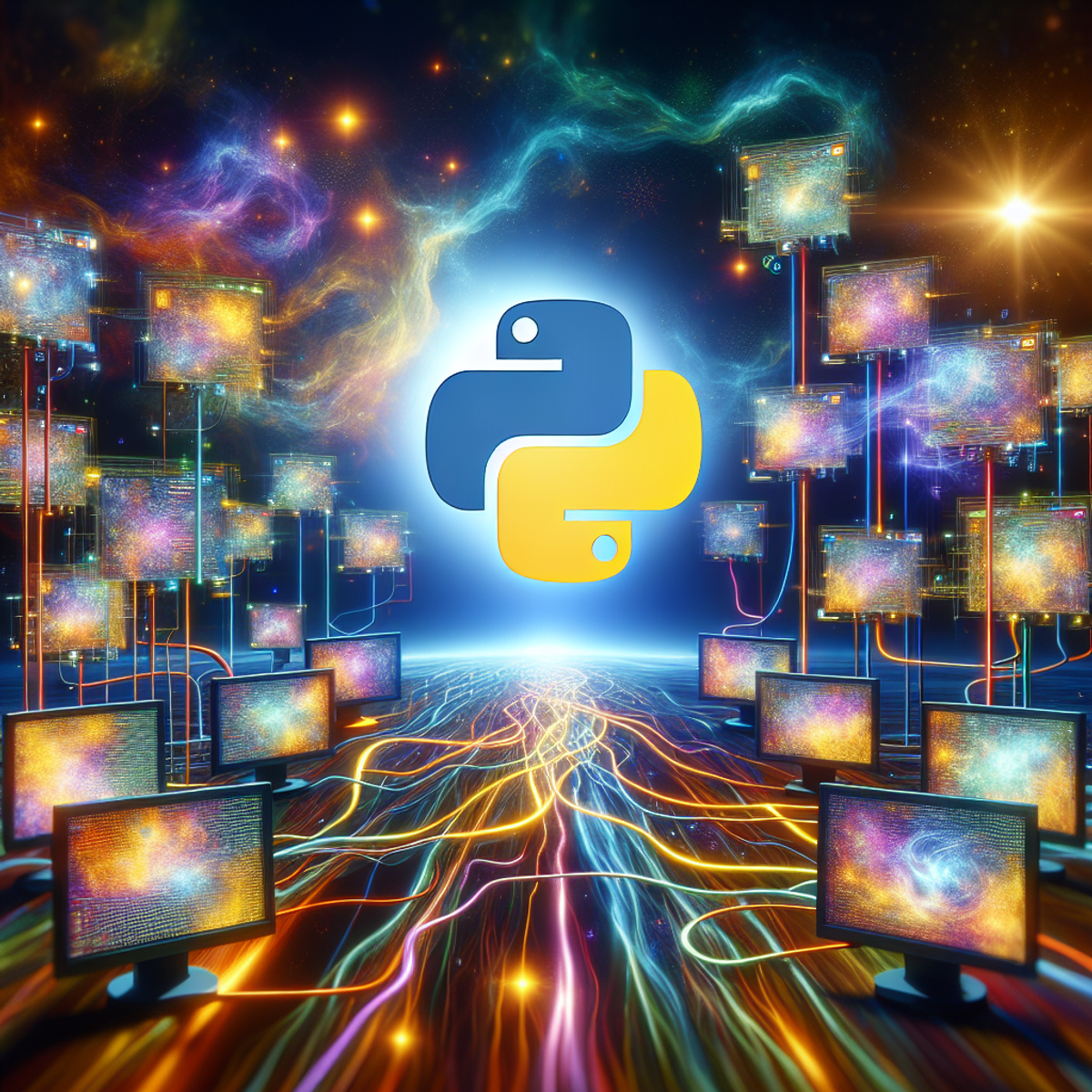Python and Big Data: Processing at Scale
Introduction
Python has emerged as a powerful programming language for big data processing due to its versatility and extensive libraries. Its simplicity and readability make it an ideal choice for handling complex data tasks. Python's rich ecosystem of libraries and frameworks provides robust support for processing large-scale datasets, making it a popular choice among data engineers and scientists.
In today's data-driven world, the volume, velocity, and variety of data have grown exponentially, leading to the need for scalable processing solutions. Processing big data at scale is crucial for extracting valuable insights, identifying patterns, and making informed decisions. Python's ability to handle large volumes of data efficiently makes it a valuable asset in the realm of big data analytics.
Distributed and parallel processing techniques are essential for handling massive datasets effectively. Python's scalability and compatibility with distributed computing frameworks enable it to distribute processing across clusters, facilitating efficient parallel processing of big data sets. This capability allows organizations to harness the power of multiple computing resources in tandem, significantly enhancing their data processing capabilities.
Python and Big Data
Python is widely used in big data processing because of its versatility and power. It provides a flexible platform for handling large-scale data analytics, making it an ideal choice for managing big data effectively.
Versatility and Flexibility
Python's versatility allows it to seamlessly integrate with various big data processing frameworks and tools. This means that data engineers and scientists can easily work with different types of datasets across various industries. Its flexibility also makes it suitable for a wide range of applications in big data, such as:
- Data preprocessing and transformation
- Advanced analytics
- Machine learning on large datasets
Integration with Big Data Frameworks
Python's scalability and ability to handle large volumes of data make it ideal for processing at scale in big data applications. Frameworks like PySpark and Dask enable Python to distribute processing across clusters, allowing for efficient parallel processing of big data sets. By leveraging Python's parallel processing capabilities, organizations can effectively manage and analyze massive datasets, gaining valuable insights for informed decision-making.
Powerful Libraries for Data Processing
Python's support for libraries like NumPy, Pandas, and TensorFlow further enhances its capabilities for processing at scale by providing powerful tools for data manipulation and analysis. These libraries offer extensive functionality for tasks such as numerical computing, data manipulation, statistical analysis, and machine learning, empowering users to perform complex operations on large-scale datasets with ease.
Seamless Machine Learning Integration
In addition to its strengths in data processing, Python excels in scalable machine learning with big data. The seamless integration of Python with frameworks like Apache Spark enables scalable machine learning on distributed clusters. This allows data scientists to build and deploy machine learning models at scale, leveraging the parallel computing capabilities of Python to train models efficiently on large datasets.
Community Support and Resources
The vibrant Python community fosters the development of open-source tools and resources tailored for big data processing. With a vast array of packages and modules available, developers can access pre-built solutions for common big data tasks, accelerating development and reducing time-to-insight.
In summary, Python's adaptability, scalability, and extensive library support make it an indispensable tool for processing big data at scale. Its seamless integration with prominent big data frameworks empowers organizations to harness the power of distributed computing for efficient analysis and extraction of insights from massive datasets. For those working in the realm of big data analytics or seeking to delve into this field, Python offers a comprehensive set of tools to tackle the challenges of processing at scale with confidence.
Processing at Scale
Python is an excellent choice for processing large amounts of data in big data applications due to its scalability and ability to handle such volumes. Its extensive collection of libraries and frameworks further enhance its capabilities, making it a popular option for efficient processing and analysis of massive datasets.
Distributed Processing with PySpark and Dask
Frameworks like PySpark and Dask enable Python to distribute processing across clusters, allowing for efficient parallel processing of big data sets.
- PySpark: Built on top of Apache Spark, PySpark provides easy integration with Python, making it a powerful tool for distributed data processing.
- Dask: Offers parallel computing in Python, enabling task scheduling and big data processing across multiple cores or nodes.
Powerful Data Manipulation and Analysis Tools
Python's support for libraries like NumPy, Pandas, and TensorFlow further enhances its capabilities for processing at scale by providing powerful tools for data manipulation and analysis.
- NumPy: Offers support for large multi-dimensional arrays and matrices, along with a collection of mathematical functions to operate on these arrays.
- Pandas: Provides high-performance, easy-to-use data structures and data analysis tools.
- TensorFlow: Enables scalable machine learning and deep learning model development, further extending Python's capabilities in big data processing.
The combination of Python's scalability, distributed computing frameworks like PySpark and Dask, and the rich ecosystem of libraries such as NumPy, Pandas, and TensorFlow makes it well-equipped to handle the challenges of processing big data at scale.
As organizations continue to deal with increasingly large volumes of data, Python's versatility in distributed computing and data analysis positions it as a valuable asset in the big data landscape.
Python Libraries for Big Data Processing
Python is widely recognized as a versatile and powerful programming language, making it an excellent choice for big data processing. Its extensive ecosystem includes a range of libraries and frameworks specifically designed to handle large volumes of data efficiently. In this section, we will explore some of the key advantages of using Python for big data processing and discuss four popular libraries that enable scalable data processing.
Advantages of using Python for big data processing:
- Ease of use: Python's simple and intuitive syntax makes it accessible to both experienced developers and those new to programming. Its readability and clean code structure facilitate collaborative work on big data projects.
- Rich ecosystem: Python boasts a vast collection of libraries and frameworks that address various aspects of big data processing, such as data manipulation, analysis, machine learning, and visualization. These resources provide developers with powerful tools to tackle complex tasks effectively.
- Integration capabilities: Python seamlessly integrates with other languages like Java and C++, allowing users to leverage existing codebases or take advantage of specialized libraries in different domains.
- Strong support for parallel processing: Python's multiprocessing module enables parallel execution by utilizing multiple processor cores. This capability is particularly valuable when dealing with computationally intensive tasks involving large datasets.
- Community support: Python has a vibrant community of developers who actively contribute to open-source projects. This rich ecosystem ensures continuous updates, improvements, and the availability of extensive documentation.
Now let's delve into four popular Python libraries that greatly facilitate big data processing:
1. Apache Spark - Overview, Key Features, Python Integration
Apache Spark is a fast and general-purpose cluster computing system built for big data processing. It provides an interface for programming entire clusters with implicit data parallelism and fault tolerance. Some key features of Apache Spark include:
- In-memory processing: Spark's ability to store intermediate results in memory enhances its performance significantly compared to traditional disk-based systems.
- Distributed computing: Spark allows for the distribution of data and computation across a cluster of computers, enabling parallel processing. This capability makes it well-suited for handling large-scale datasets.
- Python integration: Spark includes a Python API, PySpark, which provides a high-level interface for programming with Spark. PySpark enables developers to write Spark applications using Python, leveraging the language's simplicity and readability. It also provides seamless integration with other Python libraries, such as NumPy and Pandas.
2. Ray - Overview, Use Cases, Integration with Python for Distributed Computing
Ray is an open-source framework for building distributed applications that require high-performance and fault-tolerance. Its primary goal is to make it easy to write distributed Python applications that scale across a cluster. Key aspects of Ray include:
- Distributed computing: Ray facilitates the execution of parallel and distributed Python code by providing primitives for task scheduling, actor programming models, and distributed memory management.
- Flexible scaling: Ray's architecture allows users to scale their applications from a single machine to large clusters seamlessly.
- Use cases: Ray is particularly well-suited for reinforcement learning, hyperparameter tuning, real-time streaming analytics, and other scenarios that require efficient computation on large datasets.
3. Dask - Overview, Benefits, Parallel Computing with Python
Dask is a flexible library for parallel computing in Python that scales from a single machine to a cluster of machines. It seamlessly integrates with popular libraries like Pandas, NumPy, and Scikit-learn. Some key benefits of Dask include:
- Parallel processing: Dask enables developers to parallelize their existing Python code using familiar APIs like NumPy arrays or Pandas dataframes. It transparently handles the distribution of work across multiple cores or nodes.
- Scalability: Dask can efficiently scale from one machine to a cluster without requiring significant code changes.
- Interactive computing: Dask supports interactive and exploratory workflows, allowing users to analyze large datasets incrementally.
4. Polars - Overview, Features for Scalable Data Processing in Python
Polars is a blazingly fast DataFrame library implemented in Rust with a Python API. It aims to provide a high-level interface for data manipulation and analysis while delivering excellent performance. Key features of Polars include:
- Efficient query execution: Polars optimizes query execution by utilizing SIMD (Single Instruction, Multiple Data) instructions and parallel processing techniques.
- Columnar storage: Polars stores data in a columnar format, which improves both memory usage and query performance.
- Integration with other libraries: Polars integrates seamlessly with popular Python libraries like Pandas, NumPy, and PySpark, enabling users to leverage the strengths of multiple tools within their big data workflows.
Python offers a wide range of libraries that enhance its capabilities for big data processing. Apache Spark, Ray, Dask, and Polars are just a few examples of the powerful tools available to developers. By leveraging these libraries, organizations can efficiently handle large volumes of data and perform complex analytics tasks at scale. The combination of Python's simplicity and the scalability provided by these libraries makes it an ideal choice for big data processing.
Scalable Machine Learning with Python and Big Data
Scalable machine learning is a crucial aspect of big data processing, enabling organizations to derive valuable insights from massive datasets efficiently. Python, with its rich ecosystem of libraries and frameworks, provides robust support for scalable machine learning in the context of big data processing.
Importance of Scalable Machine Learning in Big Data Processing
- Handling Large Volumes of Data: In big data applications, the volume of data can be enormous, making traditional machine learning algorithms impractical. Scalable machine learning techniques allow data scientists to process and analyze large datasets without encountering performance bottlenecks.
- Efficient Resource Utilization: Scalable machine learning models are designed to leverage distributed computing resources effectively. This enables parallel processing across clusters, reducing the time required for model training and evaluation.
- Real-time Decision Making: With scalable machine learning, organizations can build and deploy models that can handle real-time data streams, facilitating timely decision-making based on up-to-date information.
Techniques for Performing Scalable Machine Learning with Python and Big Data Frameworks
1. Parallel Model Training
Python's integration with distributed computing frameworks like Apache Spark allows for parallel model training across multiple nodes in a cluster. This parallelism significantly reduces the time required to train complex machine learning models on large datasets.
2. Feature Engineering at Scale
Python libraries such as Pandas and Dask provide powerful tools for feature engineering at scale. These libraries enable data preprocessing and feature extraction on massive datasets, paving the way for building highly accurate machine learning models.
3. Scalable Model Deployment
Using Python-based frameworks like TensorFlow Serving and Ray, organizations can deploy machine learning models at scale, serving predictions to a large number of concurrent requests with low latency.
4. Integration with Distributed Data Stores
Python's compatibility with distributed data storage systems such as Apache Hadoop HDFS and cloud-based object stores allows seamless access to large volumes of data for training and inference tasks.
5. Adaptive Model Optimization
Python's support for adaptive model optimization techniques, including online learning algorithms and incremental model updates, ensures that machine learning models remain effective as new data streams in continuously.
In conclusion, scalable machine learning with Python and big data frameworks plays a pivotal role in unlocking the full potential of big data for actionable insights and informed decision-making. By leveraging Python's extensive capabilities in scalable machine learning, organizations can address the challenges of processing large volumes of data while empowering data scientists to build sophisticated models that deliver value at scale.
Specialized Courses and Specializations for Learning Python and Big Data Processing at Scale
The field of big data processing and analytics is rapidly evolving, and it is crucial to stay updated with the latest tools and techniques. Here are some key points to consider when exploring specialized courses and specializations for learning Python and big data processing at scale:
1. Explore Specialized Courses
Reputable online platforms and universities offer specialized courses on Python for big data processing at scale. These courses provide valuable insights into the practical application of Python in handling large datasets and performing distributed computing.
2. Consider Pursuing Specializations
Within the field of big data, consider pursuing specializations in scalable data management to gain in-depth knowledge and practical skills. These specializations often cover topics such as distributed computing, parallel processing, and efficient handling of large datasets using Python.
3. Topics Covered
Look for courses that cover topics such as:
- Distributed computing
- Parallel processing
- Scalable data management
- Big data technologies using Python
4. Available Resources
There are various resources available for learning about scalable data management and big data technologies using Python. Some of these resources include:
- Scalable SQL and NoSQL Data Management Solutions: These courses provide an overview of scalable SQL and NoSQL data management solutions with a focus on their relevance to Python and big data processing.
- Data Mining Algorithms: Explore courses that offer an overview of data mining algorithms with a specific emphasis on their implementation using Python for scalable data mining.
- Practical Statistical and Machine Learning Concepts: Consider courses that provide an overview of practical statistical and machine learning concepts, highlighting their application in the context of big data processing with Python.
By enrolling in specialized courses and specializations focused on Python for big data processing at scale, you can gain the necessary skills to tackle real-world challenges in the rapidly growing field of big data analytics.
The Future of Python and Big Data Processing at Scale
Python continues to be a dominant force in the big data landscape, with its versatility and scalability making it an ideal choice for processing data at scale. As organizations deal with more and more data, Python's role in generating insights and driving innovation is expected to grow even further.
Continued Growth of Python in the Big Data Landscape
The growth of Python in big data processing is driven by several factors:
- Community Support: Python has a strong and active community that constantly creates new libraries, tools, and frameworks specifically for big data processing.
- Ease of Use: Its simple syntax and extensive documentation make Python easy to learn for various users, from data engineers to machine learning experts.
- Integration with Big Data Technologies: Python seamlessly works with popular big data frameworks like Apache Spark, enabling efficient distributed computing and parallel processing.
Embracing the Challenges and Opportunities
The future of Python in big data processing depends on addressing both the challenges and opportunities that arise:
- Scalability: As datasets continue to grow rapidly, it will be crucial for Python to scale effectively across multiple systems.
- Real-time Processing: With the growing need for instant analysis, Python must adapt to handle streaming data processing at scale.
- Improved Tools: Creating more specialized libraries and tools for handling massive amounts of data will enhance Python's capabilities.
As organizations navigate the complexities of large-scale data processing, Python remains at the forefront of driving innovation and providing valuable insights. By using its strong ecosystem and embracing new technologies, businesses can efficiently process, transform, and analyze huge amounts of data confidently.
Conclusion
Python provides powerful libraries and tools for processing big data at scale, making it a popular choice for data engineers and scientists. By leveraging Python's parallel processing capabilities and distributed computing frameworks, organizations can efficiently handle large volumes of data for analysis and insights. The combination of Python and big data technologies offers a flexible and scalable solution for processing, transforming, and analyzing massive datasets, enabling businesses to make data-driven decisions with confidence.
FAQs (Frequently Asked Questions)
What is Python's role in big data processing?
Python's scalability and ability to handle large volumes of data make it ideal for processing at scale in big data applications.
What are some frameworks that enable Python to distribute processing across clusters for efficient parallel processing of big data sets?
Frameworks like PySpark and Dask enable Python to distribute processing across clusters, allowing for efficient parallel processing of big data sets.
What are some advantages of using Python for big data processing?
Python's support for libraries like NumPy, Pandas, and TensorFlow further enhances its capabilities for processing at scale by providing powerful tools for data manipulation and analysis.
Why is scalable machine learning important in big data processing?
Scalable machine learning is important in big data processing as it allows for the efficient handling and analysis of large datasets using Python and big data frameworks.
Where can I find specialized courses and specializations for learning Python and big data processing at scale?
You can explore specialized courses on Python for big data processing at scale, offered by reputable online platforms and universities. Consider pursuing specializations in scalable data management within the field of big data to gain in-depth knowledge and practical skills.
What does the future hold for Python in the big data landscape?
The continued growth of Python in the big data landscape presents opportunities for embracing the challenges of processing data at scale with Python, making it a popular choice for data engineers and scientists.


.png)
Comments
Post a Comment